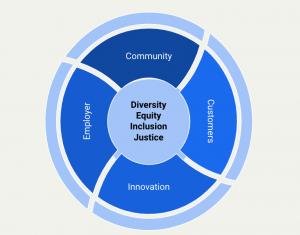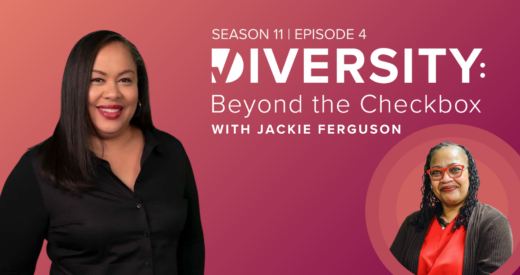Building a strong brand goes hand in hand with building a strong business. Whatever success you’re seeing in the market, it’s your brand that helps you stand out and stay relevant over time by making a memorable impression on the market and by delivering consistent value. In other words, your brand positioning helps distinguish you from competitors and enables you to effectively communicate who you are, what you do, and why you do it, thereby cultivating long-term loyalty.
In order to meet changing market demands and deliver dependable quality, your brand value should be evident at every touchpoint and should integrate diversity, equity, and inclusion (DEI) at the core of your business.
Customer expectations have changed.
A recent study from Porter Novelli examines business leaders’ opinions on purpose-driven leadership and how business should engage on both social justice and diversity, equity, and inclusion (DEI) within the context of our rapidly-changing world. The results showed that 73% of executives believe DEI is a moral and business imperative that drives profit. 71% of executives understand that, to be truly purpose-driven, a company must be willing to take risks to address social justice issues. Yet, 43% leaders cite the number of stakeholders all wanting different things as their primary reason for not taking action.
While this view is all too common, the reality is that consumers expect the brands and organizations they support to speak out and take a stand on societal issues. In fact, 70% of consumers say it’s important for brands to take a stand on social and political issues, up from 66% in 2017. This disconnect between consumers’ and business leaders’ expectations for corporate social responsibility presents an opportunity for companies to lead, or risk falling behind.
In truth, these changes started long before 2020’s global pandemic and social justice reckoning although, certainly, these life-altering events have accelerated market changes that were already occurring. Businesses and organizations that anticipated shifts in market behavior, consumer attitudes, desires, and needs have benefited from deeper relationships that span the entire value chain, and those that didn’t are clearly faltering.
Still, many organizations are hesitant to take action or to speak up on societal issues because they don’t know how to do the work, are afraid of making a mistake, or simply do not think it is important to their success. Some organizations have responded to this gap by jumping too quickly to a solution — like posting a statement of support on social media without doing the internal work first. This is a recipe for trouble that often backfires. In short, it seems the events of 2020 have worked to separate acts of performity from authenticity.
With that context in mind, how should business leaders position their brands for long-term impact?
Building a brand that is resilient and well-positioned to create future growth opportunities requires an inside-out approach to brand development and positioning. This inside-out approach could also be termed as 4D brand building — multidimensional brand development that focuses simultaneously on four key dimensions that flow outward from your corporate brand. They are: employer, community, innovation, and customer brand, or ECIC.
Yet, thinking about brands this way is counterintuitive for most leaders and their organizations as, traditionally, brand positioning begins and ends with a focus on the customer.
How do ECIC branding and DEI tie together?
The modern market is proving that, in order to build an internally- and externally-consistent ECIC brand, DEI must be woven into the core of your business and expressed in each of these four dimensions. In other words, a focus on equity for employees, for the community, in innovation, and in your target market, will help your organization to move from compliance-based diversity programs to an allyship-based diversity strategy. Let’s unpack the brand elements in more detail.
Figure 1 – ECIC Brand Growth Elements

Employer Brand
Your employer brand communicates your employee value proposition, both to potential and to existing employees. To cultivate their employer brands, many organizations spend extra time carefully curating their Glassdoor and LinkedIn profiles to create a particular impression of what it is like to work inside their organization. This is an important area of emphasis, but it’s also critical to remember that your employer brand must be connected to authentic employee experiences.
Your employer brand isn’t what the leadership team says or what HR wants to be true. It’s what candidates, new hires, and long-tenured employees believe and communicate about your business. Organizations that are able to do this well think about their employer brand as an extension of their vision and values, and that includes diversity, equity, and inclusion. Incorporating a diversity of voices and viewpoints into the talent management process is critical to success; in fact, companies that do it well have a 50% lower cost of hiring and 28% reduction in turnover. One good example of how to do this well? Netflix.
Community Brand
Your community brand communicates your value proposition in the areas where your future and existing employees live, play, or work. This dimension of your brand demonstrates the value that an organization is going to provide beyond improving the tax basis of the surrounding municipality. How will your business improve people’s lives, improve the environment, and contribute to its communities? By understanding the communities they serve, providing necessary resources for development, and working to be a good community citizen, organizations can build strong communities and community brands.
There are many organizations that spend a great deal of effort integrating themselves into new locations as they expand or relocate. One example is Toyota Financial Services, which exemplifies the value of a strong community brand by investing in underserved youth, nonprofit organizations, and a multitude of partnerships with locally-based community-improvement organizations. Many businesses also commit to skill-building and leadership development opportunities for all employees, especially those from diverse backgrounds. IBM’s New Collar program is another terrific example.
Innovation Brand
Innovation is typically viewed through a technology lens, but your innovation brand is much more broad than how or what you create technologically. It applies to all industries, services, products, and sectors. Your innovation brand shows your ability to pivot, reinvent, and adapt to changing circumstances, always with an eye to improving the future. Wondering how DEI ties to innovation branding? Study after study has shown that diversity of thought and experience leads to greater innovation and better problem solving by encouraging more and better discourse during the decision-making process.
There are many things brands can do to include more diverse people in the innovation process. For instance, you can expand your board of advisors, or create partnerships with companies led by founders from underrepresented communities. Internally, work to create a culture where the best idea wins, and where everyone is encouraged to contribute to the conversation.
In the tech sector and entrepreneur community specifically, there is much work to be done to incorporate diverse founders, employees, and companies, but what we are learning is that an early focus on DEI — especially within companies that are not yet diverse — may be the key to unlocking venture capital and private equity for emerging companies.
One good example of a strong innovation brand built around DEI is the retail chain Target. Target has long been committed to helping Black-owned businesses build their capacity to scale, and they recently announced a $2B commitment to work with Black companies. This is an important part of Target’s overall business strategy, and the fact that this announcement was made by Target’s EVP and Chief Growth Officer Christina Hennington signals loudly that working with Black founders is an important element of Target’s innovation brand.
Customer Brand
You may be surprised to see customer brand mentioned last, but that’s because it has so often been front-and-center in the marketing and brand-building conversation. Traditionally, this is where most organizations put the lion’s share of their time and energy, and rightly so. The goal of a strong customer brand is to occupy a unique space in the minds of your customers, in order to meet specific consumer needs or desires.
In terms of DEI, a diversity-focused customer brand offers a huge opportunity to expand your market. A diverse team of employees can help you build accurate insights into your diverse customers, externally, as you seek to better represent the customers and communities you serve. Inclusive marketing that features diverse people will also help you build your customer brand. To learn more, look at Gap’s Color Proud Council: a strong example of how to leverage diverse identities and perspectives for a stronger, more sustainable customer brand.
Integrate DEI into your ECIC brand development
Some organizations, like Coinbase and Basecamp, see social justice as a non-business issue and have made public statements that show they will not entertain employee dialogue on societal topics or participate in discussions on social equity. Of course, these organizations have the right to reject these “off-topic” dialogues, but doing so will take a permanent toll on their employer, community, innovation, and customer brands by signaling a uni-dimensional business whose primary interest is not corporate social responsibility but profit and efficiency alone.
How do we know that consumers and job seekers care about DEI and want brands to speak out on social issues? We follow the data, from Adobe, from McKinsey, from Edelman, and many more. In fact, when reviewing the most valuable brands of 2020, it’s clear that those which have experienced the most growth also had strong ECIC brands. They’ve worked to set themselves apart from each 4D angle: employer, community, innovation, and customer.
The core of this new brand focus is that DEI is no longer on the periphery but is central to sustainable success. Yet DEI — and advancing equity so that employees can feel safe as their full, authentic selves to contribute their best at work and in their communities — is certainly not an easy task, and if mismanaged, it can easily overwhelm.
What it requires is sustained, thoughtful, intentional effort. While there is still much work to be done on this front, it helps to see these strong examples of organizations that are embracing the notion of four-dimensional ECIC branding to nurture and develop diverse talent, diverse communities, and diverse perspectives.






